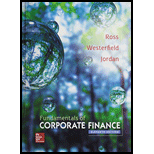
Concept explainers
Using Weighted Average Delay [LO1] A mail-order firm processes 4,900 checks per month. Of these, 60 percent are for $39 and 40 percent are for $71. The $39 checks are delayed two days on average; the $71 checks are delayed three days on average. Assume 30 days in a month.
a. What is the average daily collection float? How do you interpret your answer?
b. What is the weighted average delay? Use the result to calculate the average daily float.
c. How much should the firm be willing to pay to eliminate the float?
d. If the interest rate is 7 percent per year, calculate the daily cost of the float.
e. How much should the firm be willing to pay to reduce the weighted average float to 1.5 days?
a)
To compute: The average daily collection floats.
Introduction:
The float is the difference between the bank cash and the book cash denoting the net effects of checks in the clearing process.
Answer to Problem 6QP
Explanation of Solution
Given information:
The mail-order company processes checks of $4,900 per month. From these checks, 60% are for $39 and 40% are from $71. There is a delay of two days on an average for $39 checks and a delay of three days for $71 checks.
Explanation:
Formula to compute the average daily float:
Compute the average daily float:
Hence, the average daily float is $21,560.
b)
To compute: The weighted average delay.
Introduction:
The float is the difference between the bank cash and the book cash denoting the net effects of checks in the clearing process.
Explanation of Solution
Given information:
The mail-order company processes checks of $4,900 per month. From these checks, 60% are for $39 and 40% are from $71. There is a delay of two days on an average for $39 checks and a delay of three days for $71 checks.
Answer: The weighted average delay is 2.55 days.
Formula to compute the total collections:
Compute the total collections:
Hence, the total collection is $253,820.
Formula to compute the weighted average delay:
Compute the weighted average delay:
Hence, the weighted average delay is 2.55 days.
c)
To compute: The amount the company will be willing to pay to avoid the float.
Introduction:
The float is the difference between the bank cash and the book cash denoting the net effects of checks in the clearing process.
Answer to Problem 6QP
Explanation of Solution
Given information:
The mail-order company processes checks of $4,900 per month. From these checks, 60% are for $39 and 40% are from $71. There is a delay of two days on an average for $39 checks and a delay of three days for $71 checks.
Formula to compute the average daily float:
Compute the average daily float:
Hence, the average daily float is $21,560.
d)
To compute: The daily float cost, if the rate of interest is 7% per year.
Introduction:
The float is the difference between the bank cash and the book cash denoting the net effects of checks in the clearing process.
Answer to Problem 6QP
Explanation of Solution
Given information:
The mail-order company processes checks of $4,900 per month. From these checks, 60% are for $39 and 40% are from $71. There is a delay of two days on an average for $39 checks and a delay of three days for $71 checks.
Formula to compute the average daily rate of interest:
Compute the average daily rate of interest:
Hence, the average daily rate is 0.01854% per day.
Formula to compute the daily float cost:
Compute the daily float cost:
Hence, the daily float cost is $4.00.
e)
To compute: The amount that the company will be willing to pay to decrease the weighted average float to 1.5 days.
Introduction:
The float is the difference between the bank cash and the book cash denoting the net effects of checks in the clearing process.
Answer to Problem 6QP
Explanation of Solution
Given information:
The mail-order company processes checks of $4,900 per month. From these checks, 60% are for $39 and 40% are from $71. There is a delay of two days on an average for $39 checks and a delay of three days for $71 checks.
Formula to compute the new average daily float:
Compute the new average daily float:
Hence, the new average daily float is $12,691.
Formula to compute the maximum payment amount:
Compute the maximum payment amount:
Hence, the maximum amount the firm will be willing to pay is $8,869.
Want to see more full solutions like this?
Chapter 19 Solutions
Fundamentals of Corporate Finance with Connect Access Card
 EBK CONTEMPORARY FINANCIAL MANAGEMENTFinanceISBN:9781337514835Author:MOYERPublisher:CENGAGE LEARNING - CONSIGNMENT
EBK CONTEMPORARY FINANCIAL MANAGEMENTFinanceISBN:9781337514835Author:MOYERPublisher:CENGAGE LEARNING - CONSIGNMENT Essentials of Business Analytics (MindTap Course ...StatisticsISBN:9781305627734Author:Jeffrey D. Camm, James J. Cochran, Michael J. Fry, Jeffrey W. Ohlmann, David R. AndersonPublisher:Cengage Learning
Essentials of Business Analytics (MindTap Course ...StatisticsISBN:9781305627734Author:Jeffrey D. Camm, James J. Cochran, Michael J. Fry, Jeffrey W. Ohlmann, David R. AndersonPublisher:Cengage Learning

